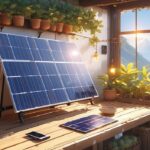Looking to harness the power of the sun and wondering how solar panels can be utilized? In this article, we delve into the top 10 practical solar panel applications that showcase the myriad ways we can tap into this sustainable energy source. As a seasoned renewable energy expert, I have compiled a comprehensive list of solar panel uses that range from powering residential homes to revolutionizing entire industries. Whether you are interested in the economic feasibility of solar power or curious about the latest innovations in solar technology, this article has you covered. Let’s explore the possibilities of solar panels and their immense potential for a greener future.
Key Takeaways:
- Solar panels can serve as the main or sole source of electricity, providing overall power supply.
- They are commonly used for heating water, offering an efficient and sustainable alternative to traditional water heaters.
- The sun’s energy can be harnessed to power water pumps, ensuring a continuous supply of water.
- Solar panels can be utilized for solar ventilation, providing a natural and eco-friendly way to regulate indoor temperatures.
- Outdoor solar lighting can be achieved through the installation of solar panels, eliminating the need for conventional power sources.
- Portable equipment can be powered by solar panels, enabling convenient and sustainable energy solutions on the go.
- Solar panels can be used to charge batteries, offering a renewable energy source for various devices.
- Cooking can be done using solar panels through specially designed solar cookers, reducing reliance on traditional fossil fuel-based cooking methods.
- Solar panels can be employed for electricity production, generating clean and renewable energy.
- One of the key benefits of solar panels is their ability to produce electricity in remote locations, making them an ideal solution for off-grid power supply.
- By reducing reliance on traditional electricity sources, solar panels can effectively lower electricity bills.
- Solar panels can also be utilized to generate income through government incentives and programs.
- Implementing solar panels contributes to reducing one’s carbon footprint and promoting sustainable practices.
To learn more about practical solar panel applications, visit the following websites:
– Ourendangeredworld.com: Different Uses for Solar Panels
– Clean-energy-ideas.com: What Are Solar Panels Used For?
10 Uses of Solar Panels

Solar panels have revolutionized the way we generate and utilize energy, offering numerous practical applications that benefit individuals, communities, and the environment. In this article, we will explore the top 10 uses of solar panels and their immense potential in transforming our energy landscape.
1. Overall Power Supply
Imagine relying on the sun to power your entire household or business. With solar panels installed, this is entirely possible. By harnessing the sun’s energy, solar panels can serve as your main, and potentially only, source of electricity. Not only does this provide independence from traditional energy sources, but it also offers long-term cost savings.
2. Water Heater
Solar panels are commonly used to heat water, providing a sustainable and cost-effective solution. By utilizing the sun’s rays, solar water heaters can significantly reduce the energy consumption required for this purpose. Whether it’s for your home, swimming pool, or other applications, solar panels can efficiently heat water without harming the environment.
3. Powered Water Supply
In areas where access to electricity is limited, solar panels can power water pumps, offering a reliable and sustainable solution for communities. This is particularly beneficial in remote locations or regions prone to power outages. With solar-powered water supply systems, communities can gain access to clean water without relying on traditional energy sources.
4. Solar Ventilation
Solar panels can also be used to power ventilation systems, keeping indoor spaces cool and comfortable. By utilizing solar energy, these systems reduce reliance on grid power, resulting in energy savings and lower electricity bills. Solar-powered ventilation is especially advantageous in areas with high temperatures or limited access to electricity.
5. Outdoor Solar Lighting
Efficient and versatile, solar panels can power outdoor lighting systems, illuminating pathways, gardens, and other outdoor spaces. These lighting systems are not only aesthetically pleasing but also provide enhanced safety and security during nighttime. By utilizing solar energy, outdoor solar lighting eliminates the need for complex wiring and reduces ongoing maintenance costs.
6. Portable Equipment
Solar panels can be integrated into portable equipment such as solar chargers, backpacks, and even small gadgets. This allows for convenient charging on the go, whether you’re camping, hiking, or simply spending time outdoors. With portable solar-powered solutions, you can keep your electronic devices charged without relying on traditional power sources.
7. Battery Charging
Solar panels can charge batteries, providing a reliable source of stored energy. This is particularly useful in off-grid settings or during power outages when a backup power supply is essential. By using solar energy to charge batteries, you can ensure uninterrupted power availability for various applications, including emergency lighting, communication devices, and small appliances.
8. Cooking
Solar panels can be utilized for cooking, offering an eco-friendly alternative to traditional stovetops and ovens. By using solar-powered cookers or ovens, you can harness the sun’s energy to prepare meals without relying on fossil fuels or electricity. Solar cooking not only reduces carbon emissions but also promotes sustainability in daily activities.
9. Electricity Production
One of the primary purposes of solar panels is to generate electricity. Whether it’s for residential, commercial, or industrial purposes, solar panels can transform sunlight into clean and renewable electrical energy. By installing solar power systems, you can contribute to the growth of sustainable energy while reducing your reliance on traditional power grids.
10. Remote Power Supply
One of the key advantages of solar panels is their ability to provide electricity in remote areas where access to power is limited. By harnessing the sun’s energy, solar panels can power essential services, such as telecommunications, healthcare facilities, and educational institutions. This is particularly beneficial in rural communities or during disaster situations.
Solar panels offer numerous practical uses that go beyond traditional electricity generation. From providing power supply and heating water to reducing electricity bills and minimizing carbon footprints, their versatility and sustainability make them a valuable asset in transitioning towards a cleaner and brighter future.
Sources:
- Ourendangeredworld.com: Different Uses for Solar Panels
- Clean-energy-ideas.com: What Are Solar Panels Used For?
In our modern world, finding sustainable sources of energy has become increasingly important. If you’re curious about the different uses of renewable energy, check out our article on 10 uses of renewable energy. Discover how renewable energy can power our lives while reducing environmental impact.
Additionally, solar energy is a popular form of renewable energy that is widely used in our daily lives. Are you interested in exploring the various ways solar energy can benefit us? Learn about 10 uses of solar energy in our daily life and uncover innovative ways to harness the power of the sun for a greener future.
Solar Panels for Sustainable Agriculture

Greenhouse solar panels are revolutionizing the way we grow food by harnessing the power of the sun. These panels offer numerous advantages and potential drawbacks, but the benefits they provide to sustainable agriculture are invaluable. Let’s explore the ten practical uses of solar panels in promoting sustainable agriculture.
1. Greenhouse Solar Panels
Solar panels in greenhouses have the dual purpose of harnessing solar energy and protecting crops. They effectively harvest the power of the sun twice, providing shade protection for plants while generating electricity. By using solar panels in greenhouses, we can optimize crop cultivation and create ideal microclimate conditions.
2. Agrivoltaic Farming
Agrivoltaic farming is the practice of growing crops under solar panels. This innovative approach combines solar energy and agriculture, providing benefits such as shade protection for crops and an increased range of higher-value crops. Agrivoltaic systems are particularly useful in areas with limited land availability, as they maximize the use of available space.
3. Improved Irrigation Efficiency
Agrivoltaic systems also have the potential to improve irrigation efficiency, especially in arid regions. By utilizing solar panels to generate electricity for irrigation systems, water can be efficiently distributed to crops, reducing water wastage and maximizing agricultural productivity. This sustainable approach contributes to water conservation and supports the growth of crops in water-scarce areas.
4. Off-Grid Electrification in Rural Areas
Solar photovoltaic systems offer a reliable solution for rural electrification projects. In remote areas with limited access to power, solar panels can generate electricity to power essential services such as telecommunications, healthcare facilities, and educational institutions. This enhances the quality of life for communities and facilitates economic development.
5. Sustainable Water Pumping
Solar panels can power water pumps, making them an ideal solution for areas with limited access to electricity. By utilizing solar energy, communities can have a reliable and sustainable source of power for pumping water. This not only provides access to clean water but also supports irrigation for agricultural purposes.
6. Energy-Efficient Ventilation
Solar panels can power ventilation systems, reducing reliance on grid power and lowering electricity costs. By harnessing solar energy for ventilation, agricultural facilities can maintain optimal temperature and humidity levels. This enhances crop growth and reduces the environmental impact of traditional ventilation systems.
7. Eco-Friendly Cooking
Solar panels can be used for cooking, offering an eco-friendly alternative to traditional stovetops and ovens. Solar cookers utilize the sun’s energy to heat food, eliminating the need for fossil fuels. This promotes sustainable practices in agriculture and reduces greenhouse gas emissions.
8. Sustainable Electrification for Agriculture
Solar panels can generate electricity for various agricultural purposes, contributing to sustainable energy growth and reducing reliance on traditional power grids. Whether it’s powering farm equipment, electric fences, or lighting systems, solar energy provides a clean and affordable source of power for agricultural operations.
9. Enhanced Livestock Farming
Solar panels can also benefit livestock farming by providing electricity for heating and lighting systems in barns and sheds. This improves animal welfare and productivity while reducing operating costs and environmental impact. Solar-powered electric fences are also an effective and sustainable solution for livestock containment.
10. Sustainable Energy Education
Solar panels offer educational opportunities for farmers and communities. They can be integrated into renewable energy education programs, enabling individuals to learn about sustainable practices and technology. This knowledge empowers farmers to make informed decisions and adopt sustainable agricultural practices for a greener future.
Key Takeaways:
- Greenhouse solar panels optimize crop cultivation and provide shade protection for plants while generating electricity.
- Agrivoltaic farming combines solar energy and agriculture, expanding crop options and utilizing limited land availability.
- Solar panels improve irrigation efficiency, supporting water conservation in arid regions.
- Solar-powered systems enable off-grid electrification in rural areas, powering essential services and fostering economic development.
- Solar panels provide a sustainable and reliable solution for water pumping in areas with limited access to electricity.
- Ventilation systems powered by solar panels reduce reliance on the grid and lower electricity costs.
- Solar cookers offer an eco-friendly alternative for cooking, reducing reliance on fossil fuels.
- Solar panels promote sustainable electrification for various agricultural purposes, reducing reliance on traditional power grids.
- Livestock farming can benefit from solar panels by providing electricity for heating and lighting systems, improving animal welfare and reducing costs.
- Solar panels contribute to sustainable energy education, empowering individuals to adopt green practices in agriculture.
Citations:
– Greenhouse solar panels: Anker
– Agrivoltaic farming benefits: World Economic Forum
– Land competition and solar panels: Statkraft
– Irrigation efficiency in arid regions: Frontiers
– Solar panels for rural electrification: Environment and Natural
Solar-powered Transportation
Solar power and electric cars have come a long way since their development in the 1950s. Today, they are merging to revolutionize transportation and pave the way for a greener future. With its renewable and sustainable nature, solar energy is an ideal power source for various transportation technologies. In this article, we will explore the top 10 different types of solar transportation technologies that are changing the way we travel.
1. Solar Trains
Solar trains are an emerging transportation solution that holds immense potential. The first solar-powered railway has already been established, demonstrating the viability of solar energy in powering larger transportation systems.
2. Solar Planes
Technological innovation is not limited to the ground. Solar planes, although not yet commercially viable, have made impressive flights. The Solar Impulse 2 is a prime example of a solar-powered plane pushing the boundaries of aviation.
3. Solar Bikes and Scooters
Solar technologies have the potential to revolutionize electric bicycles and scooters. By integrating solar panels into their design, these vehicles can harness clean energy from the sun, reducing their reliance on traditional power sources.
4. Solar Roads
The construction of roads presents an opportunity to generate solar energy. Companies like Solar Roadways are developing hexagon-shaped solar roads that can generate energy while providing a safe and durable surface for transportation.
5. Solar-powered Public Transport
Solar-powered public transport aims to reduce dependence on fossil fuels. Initiatives like the introduction of electric buses powered by solar energy in Shanghai are steps in the right direction, promoting clean energy and reducing air pollution.
6. Solar Cars
Solar-powered cars are a growing trend in the transportation industry. These cars are equipped with solar panels that generate electricity to power the vehicle, reducing reliance on traditional fuel sources.
7. Solar Ferries
Solar-powered ferries are gaining popularity as a sustainable alternative for water transportation. By utilizing solar energy to power their propulsion systems, these ferries significantly reduce carbon emissions.
8. Solar-powered Aircrafts
Solar energy is also being explored as a power source for aircraft. Solar-powered drones, for example, have demonstrated the potential to revolutionize surveillance and aerial monitoring operations, operating for extended periods without the need for fuel.
9. Solar-powered Rideshare Services
Rideshare services are increasingly embracing solar energy. Companies are utilizing solar-powered charging stations for their electric vehicle fleets, reducing reliance on traditional charging infrastructure and promoting sustainable transportation options.
10. Solar-integrated Bicycle Paths
Bicycle paths integrated with solar technology have the potential to generate electricity while providing a safe and eco-friendly way for cyclists to commute. These solar-integrated paths can also power streetlights and nearby infrastructure, further promoting renewable energy use.
These ten different types of solar transportation technologies showcase the versatility and potential of solar power in revolutionizing the way we travel. By harnessing the power of the sun, these innovations offer sustainable and renewable alternatives to traditional transportation systems. Embracing solar energy in transportation is crucial in reducing carbon emissions and combating climate change.
Sources:
[^1^]: Solar Trains – SolarPowerNerd
[^2^]: Solar Planes and Solar Vehicles – Solar Power Reviews
[^3^]: Solar Bikes and Scooters: The Future of Transportation? – Energy5
[^4^]: Solar Roads: Paving the Way for Sustainable Energy – Solar Power Nerd
[^5^]: Solar Powered Transportation: Future Concepts, Trends and More – Ecofriend
[^6^]: Could Solar Trains Be The Future Of Public Transportation? – Solar Power Nerd
[^7^]: Fuelling PV progress: How solar can be used in transport – Enlit World
Key Takeaways:
- Solar power is being integrated into various transportation technologies, including trains, planes, bikes, scooters, roads, public transport, cars, ferries, aircrafts, rideshare services, and bicycle paths.
- Solar transportation technologies offer sustainable and renewable alternatives to traditional methods, reducing carbon emissions and combating climate change.
Solar Panel Applications in Space Technology
Space exploration and technology have always pushed the boundaries of innovation, and solar panel applications are no exception. As we look toward a future where sustainable energy solutions are crucial, incorporating solar panels in space technology holds great promise. In this article, we will explore the ten most practical and impactful uses of solar panels in space technology, and how they are shaping the future.
Solar Power in Space: Brightening the Possibilities
Solar panels have already played a vital role in space applications, powering interplanetary probes and satellites. These panels, often reaching an impressive total area of about 85m2, represent the largest solar panel surface ever built for space purposes[^1^]. But the potential of solar panels in space technology goes beyond just that.
Imagine a future where large orbital arrays of solar panels capture solar energy in space and beam it to Earth using microwave technology[^3^]. This concept has drawn attention from influential supporters and is considered a potential solution for our future energy needs.
How Solar Panels Work in Space
To understand the diverse applications of solar panels in space technology, it’s essential to grasp how they function in this unique environment.
Solar panels in space utilize a combination of self-assembling satellites, reflectors, and microwave or laser power transmitters[^4^]. Reflectors or inflatable mirrors direct solar radiation onto solar panels, which then convert the solar power into either microwaves or lasers. This power is subsequently beamed down to Earth.
Exploring New Technologies
With advancements in solar cell technologies, such as copper indium gallium selenide (CIGS) and perovskite solar cells (PSCs), solar panels are becoming more efficient and versatile for aerospace power systems[^5^]. These lightweight and flexible solar cells are cost-effective to manufacture and exhibit exceptional resistance to radiation.
Practical Uses of Solar Panels in Space Technology
Now, let’s dive into the top ten practical uses of solar panels in space technology:
1. Solar-Powered Satellites: The use of solar panels in space enables satellites to harness the sun’s energy, providing power for various functions, including running sensors, active heating/cooling, telemetry, and electrically powered propulsion[^6^].
2. Interplanetary Probes: Solar panels are the primary power source for interplanetary probes, ensuring their long-term functionality and enabling scientific research beyond our planet.
3. Orbital Solar Arrays: Constructing large arrays of solar panels in space and beaming the generated power to Earth represents a potential future energy solution, reducing reliance on traditional power grids[^3^].
4. Solar-Powered Rovers: Rovers, like the ones exploring the surface of Mars, utilize solar panels to generate electricity for their operations, enabling them to roam and conduct experiments.
5. Satellite Communications: Solar panels play a crucial role in powering the communication systems of satellites, ensuring reliable and uninterrupted telecommunications.
6. Remote Sensing: Solar panels enable satellites to power their sensors and instruments, facilitating crucial remote sensing operations for weather forecasting, environmental monitoring, and data collection.
7. Space Telescopes: Solar panels provide the primary source of power for space telescopes, allowing us to explore the universe and gather valuable astronomical data.
8. GPS Systems: Solar panels power the Global Positioning System (GPS) satellites, providing accurate location and navigation services around the globe.
9. Plasma Propulsion Systems: Solar panels contribute to powering electric propulsion systems for spacecraft, enabling efficient and long-duration missions in space.
10. Lunar Missions: Solar panels have also been instrumental in powering lunar missions, providing the necessary energy for various scientific experiments and exploration activities.
Key Takeaways:
- Solar panels have practical applications in space technology, including powering satellites, probes, rovers, and space telescopes.
- The concept of large orbital arrays of solar panels in space can potentially beam power to Earth and contribute to future energy solutions.
- New solar cell technologies, such as CIGS and PSCs, offer lightweight, flexible, and radiation-resistant options for aerospace power systems.
Discovering the diverse applications of solar panels in space technology opens up new frontiers in sustainable energy usage and brings us closer to a greener and more self-sufficient future.
Sources:
[^1^]: Wiley Online Library – Solar PV Cell Technologies_Spaceships
[^3^]: ABC News – Solar Panels in Space Could Beam Power to Earth
[^4^]: Department of Energy – Solar Power Systems in Space
[^5^]: Wiley Online Library – New Solar Cell Technologies for Aerospace Power Systems
[^6^]: Wikipedia – Solar Panels for Spacecraft
FAQ
Q1: What are some practical uses for solar panels?
A1: Some practical uses for solar panels include providing overall power supply, heating water, powering water pumps, powering ventilation systems, outdoor lighting, and charging portable equipment.
Q2: Can solar panels be used for cooking?
A2: Yes, solar panels can be used for cooking. They can be used to power solar cookers or solar ovens, which harness the sun’s energy to cook food.
Q3: How can solar panels help reduce electricity bills?
A3: Solar panels can help reduce electricity bills by generating electricity from the sun’s energy. This self-generated power can offset the need for grid electricity and lower overall energy costs.
Q4: Can solar panels be used to make money?
A4: Yes, solar panels can be used to make money. Through programs like net metering or feed-in tariffs, excess electricity generated by solar panels can be sold back to the grid, allowing for a potential income stream.
Q5: How do solar panels contribute to reducing carbon footprint?
A5: Solar panels contribute to reducing carbon footprint by generating clean, renewable energy without emitting greenhouse gases. By using solar panels instead of fossil fuel-based energy sources, carbon emissions associated with electricity production are significantly reduced.
- Sept 31 Myth: Unveiling Calendar Secrets - March 18, 2025
- How Long & Till December 18, 2025: Accurate Countdown Guide - March 18, 2025
- Discover Japanese Artists: A Complete History - March 18, 2025
















